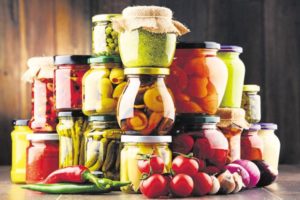By AREEBA HUSSAIN – Reports Healthcare

Fresh jalapeno plant
Jalapeños are those spicy chili peppers that you often add to your favorite fast food. They belong to the hot pepper family and due to their distinctive taste; it is easier to add them to many recipes.
Naturally, they are small and green or red. They are spicier than green chilies. Mexican cuisine is the hub of jalapeños enriched food. The distinctive taste of Mexican food, flavored by jalapeños makes it famous worldwide.
Surprisingly, jalapeños are not just any spice. It has its health benefits to offer. It is loaded with nutrients that are healthy by many ways. This article will explain the hidden benefits of eating jalapeños. Also, it will discuss their possible side effects and suggest you the means to use add them.
High nutritional value
Jalapeños have minimum calories in them. They have high amounts of vitamins, minerals, fiber and antioxidants in them. You wouldn’t believe but following is the list of ingredients in only one raw jalapeño.
- Total calories:4
- Fiber:4 grams
- Vit C:10% of the RDI
- Vit B6: 4% of the RDI
- Vit A:2% of the RDI
- Vit K:2% of the RDI
- Folate:2% of the RDI
- Manganese:2% of the RDI
Jalapeño is a spice, but like most of the fruits and vegetables, it has a certain amount of fiber in it. It means that one pepper provides the user 2% of the RDI consuming 2,000 calories per day.
Jalapeño is also high in vitamins like vitamin C and vitamin B6. Vitamin C is found in citrus fruits, it is an antioxidant, which fights against the free radical damage and makes your skin healthy. On the other hand, vitamin B6 plays a key role in more than140 bodily reactions.
Helpful in weight loss
Jalapeños are most likely to help you for losing weight by metabolic boost. They increase your overall fat burn and also play action to suppress your hunger pangs. Jalapeños have a vital compound called capsaicin, and similar compounds called capsaicinoids that are evident to be capable of boost metabolismby 4–5% per day. In this way, it is easy to lose weight when you eat jalapeños.
Additionally, they also help to get rid of the stubborn belly fat and reduce appetite. That is why spices, particularly, jalapeños help to lose weight.
Helpful against Cancer
Many studies show the anticancer capacity of capsaicin. It is so powerful that it can even kill over 40 different types of cancer cells. The best thing is that it has no damaging effect on healthy cells.
As per the study, it can do the following things.
- Stops the growth of cancer cells.
- Prevent them from dividing.
- Prohibits the formation of blood vessels around cancer cells.
- Prevents the cancer cells to spread in the entire body.
However, the studies proving these effects are not targeted to humans. For the effects on humans, there is a dire of more extensive studies.
Acts as a painkiller
When it comes to medicinal benefits, capsaicin is a highly effective pain reliever when used externally on the skin. It works by soothing the pain by blocking the skin receptors that sense it.
When you apply it on the skin, at first, you may feel a burning sensation. After that, you will feel your skin to be numbed, and the pain is completely gone. For this reason, capsaicin is also used in lotions and patches that are targeted to relieve pain. This pain could be related to anything such as infectious, diabetic nerve pain and chronic muscle and joint pain.
Is helpful against stomach ulcers
There are so many reasons for stomach ulcers to be formed such as;
- H pylori bacterial infection
- Stomach acid
- Disturbed blood flow
- Excessive NSAID pain relievers
- alcohol
- Smoking
- Stress and fatigue
The capsaicin in all chili peppers is helpful to protect the stomach from developing ulcers. However, it is not clear if jalapeños have sufficient quantity of capsaicin for this effect or not.
Protects the body against infections
Most of the spices and herbs have a traditional use to prevent food spoilage and food poisoning. The compounds of spicy chili peppers such as jalapenos are very helpful to reduce the growth of common bacteria and yeas.
They also help from bacterial toxins to spread and reduce the risk of foodborne diseases. Not just this, capsaicin also helps to prevent other types of infections, such as strep throat, tooth decay, and chlamydia.
But the important thing is that all these studies have used chili extracts and not whole chilis. Also, these tests were conducted in the lab but not on human subjects. Further research is required to study it.
Cardiac health
The biggest contributors of heart problems are diabetes, high cholesterol, and high blood pressure. Research says that capsaicin may be helping reduce the impact of these risk factors and its role in keeping your heart healthy.
Capsaicin is evident to lower cholesterol and lipid levels in animals, but this has not been proven on human subjects yet. It is further explained that this property is due to the lowering in blood pressure by relaxing blood vessels, however, there is no research to prove this to be true in humans.
Possible Side Effects
It doesn’t look like that there will be any side effects of jalapeño. In fact, there are so many promising health benefits of it. But you must know about its potential side effects too.
The most common side effect to get from eating any chili is burning of the mouth. If it is very spicy, there are high chances that it will cause moderate to severe burning. If a person is not tolerant to spices, it is not advisable for him to eat chilies, regardless of their amazing taste.
Take care of the following things before you eat them.
- Do not scar the chilies.
- Use gloves whole cutting and handling chilies
- Avoid using the unwashed hands on any part of the body, particularly eyes.
- Remove the white membranes inside the jalapeño before using them.
- In case of burning, drink milk.
People with metabolic problems such as irritable bowel syndrome may experience some unpleasant experiences while using anything spicy. For them eating chilies is not a good choice so it is better to avoid it. The common side effects to hit them are abdominal pain, burning, cramping, and diarrhea.
If you are using dried or stored chilies, there is a high risk of contamination with aflatoxin, which is a particular type of mold that grows on certain foods in exceptional conditions. In all such cases, it is recommended not to use chilies and other types of spices.



